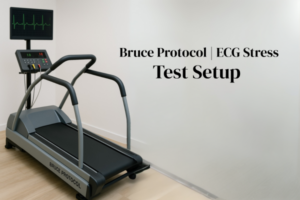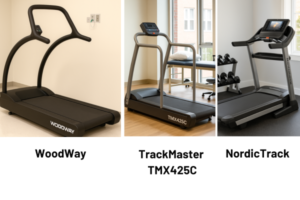Follow my blog with Bloglovin Introduction – Why This Test Matters in 2025
Curious about how long you should last on a treadmill stress test? This complete guide breaks down the average time on treadmill for stress test by age—plus expert advice, product picks, and personal insight.
If your doctor has ever recommended a treadmill stress test, you’re not alone—and you’re probably wondering what “normal” looks like. By 2025, the test remains to be one of the surest methods of testing the performance of your heart when it has been pushed to the limit. But how do you know what’s expected at your age? That’s where the Average Time on Treadmill for Stress Test by Age becomes essential.
So, let us go through what this test really tells you, how your age comes into play and what you can make your time on the treadmill that can be powerful in terms of cardiac well-being.
Why Timing on the Treadmill Reflects More Than Just Fitness
It’s not just about lasting longer than your gym buddy. The time you stay on during a treadmill stress test offers deep insight into your cardiovascular capacity. Think of it as a real-time preview of your heart’s health.
The Growing Importance of Age-Based Benchmarks
In 2025, health data is more personalized than ever. By this we do not mean that doctors are seeking out one-size-fits-all figures; they are holding your performance up to those of your peers. It helps paint a clearer picture of what’s normal, what’s excellent, and what might need improvement.
How This Guide Helps You Prepare, Compare & Improve
We’ll cover everything—from average time on treadmill for stress test by age to expert insight, product reviews, and even a personal review of someone who’s been there. Let’s dive in!
User Spotlight – Who Typically Takes a Treadmill Stress Test? 🧍♀️
- The Retired Professional Monitoring Heart Health (60+): Mr. Ahmed, 67, recently started walking daily after his doctor suggested keeping an eye on his blood pressure. The treadmill stress test gave him a benchmark and peace of mind.
- The Busy Mid-Ager Trying to Prevent Future Problems (40–59): People in this age group—like Sara, a working mom—use the test to check for early signs of heart strain, especially if there’s family history.
- The Curious First-Timer in Their 20s–30s: Younger individuals may be surprised when their doctor suggests a test after reporting chest discomfort or fatigue. It’s all about early detection.
- The Recovery Warrior (Post-Surgery or Cardiac Rehab Patient): Rehab patients often undergo regular treadmill stress tests to track progress. These results can motivate or help fine-tune recovery plans.
What Is a Treadmill Stress Test?
Understanding the Bruce Protocol: The Bruce Protocol is a standardized way to perform stress tests. It increases the treadmill’s speed and incline every three minutes until you reach your physical limit.
What Medical Teams Measure: They are not simply checking how fast you are running but the rate of your heart, breathing, blood pressure, ECG change, and the ability of your body to handle stress.
Real-Time Monitoring & Endurance Scoring: Results show how your heart responds under stress. More endurance generally equals better heart function.

Expert Opinions – What Cardiologists Look For 👨⚕️
Dr. Ayaz’s View: “Time on the treadmill equals risk level.”
He explains that staying longer typically indicates a lower risk of cardiovascular disease.
Dr. Anum Fatima: “Fitness age is a better predictor than real age.”
Dr. Fatima emphasizes performance over birth year. Your test time may reveal you’re fitter—or more at risk—than your age suggests.
How Professionals Define ‘Normal’ by Age Groups: Cardiologists use age-adjusted charts and risk scoring models to interpret your results. This is where our next section on the Average Time on Treadmill for Stress Test by Age becomes essential.
Average Time on Treadmill for Stress Test by Age ⏱️
| Age Group | Average Time (Minutes) |
|---|---|
| 20–29 | 12–14 min |
| 30–39 | 10–13 min |
| 40–49 | 9–11 min |
| 50–59 | 8–10 min |
| 60–69 | 7–9 min |
| 70+ | 6–8 min |
Time Benchmarks for Males vs Females: Men often perform slightly longer due to muscle mass, but women tend to be more consistent in pacing and recovery.
What Time Ranges Indicate “Excellent,” “Average,” or “Risk” Levels
Excellent: Exceeding age range by 1–2 minutes
Average: Within the standard for your group
At Risk: Below average or early termination
Personal Review – My Experience Taking the Treadmill Stress Test ✍️
Preparing for the Day: I avoided caffeine, wore my most comfortable sneaker and ensured I had a good sleep. The most important thing was hydration.
What Happened During the Test: The technician explained every step. At first, it felt like a brisk walk, but each stage ramped up fast!
My Recorded Time vs National Average: I clocked in at 9 minutes—just at the lower end of the average for my age (30s). A slight wake-up call.
Key Takeaways + Confidence Boost or Wake-Up Call? Honestly, it inspired me to enhance my stamina. It wasn’t about passing or failing—it was about knowing.

The WOW Factor – What Your Time Really Reveals 💥
Estimating Your “Fitness Age” From Your Score:
Fitness age often reflects your cardiovascular age better than your birth year, and the Average Time on Treadmill for Stress Test by Age helps reveal that difference. You might be 45 but perform like a 35-year-old—or vice versa.
Why a 65-Year-Old Can Outperform a 30-Year-Old:
Consistent training, clean eating, and mindset matter more than just age.
How Cardiac Output and Endurance Beat Chronological Age:
The real goal? Better heart output and stamina. These tell more than your date of birth ever could, especially when compared to the Average Time on Treadmill for Stress Test by Age.
Factors That Influence Your Test Time
Physical Fitness, Weight & BMI
Greater fitness and desirable body mass category typically result in more endurance.
Chronic Conditions (Diabetes, BP, Cardiac History)
These may shorten test duration but also highlight areas needing medical focus.
Gender, Stress, Medications
Your biology and medication can affect heart rate response. Stress plays a surprising role, too.
Your Sleep & Nutrition the Day Before
Poor sleep or low blood sugar can derail your performance—even if you’re in good shape.
Product Review – Best Treadmills for Stress Test Simulation 🏃♀️
1. Woodway Desmo S Treadmill (🏥 Medical Grade)
Top 5 Differentiators:
- Medical-level precision
- Accurate incline control
- ECG-compatible
- Durable hospital-grade build
- Quiet motor for clinical spaces
Price: $11,500–$14,000
Who Should Use: Clinics, labs
2. TrackMaster TMX425C (Clinical-Ready)
Features:
- Smooth ECG sync
- Adjustable handrails
- Rehab-specific incline settings
- Compact design
Price: $8,000–$10,000
Who Should Use: Cardiac rehab facilities
3. NordicTrack Commercial 1750 (🏠 Home Simulation)
Features:
- 15% incline
- On-demand workouts
- Not Bruce Protocol certified
- Great for endurance training
Price: $1,999
Who Should Use: Home users prepping for tests

Side-by-Side Comparison: Medical vs Home Treadmills 📊
| Feature | Woodway Desmo | TMX425C | NordicTrack 1750 |
|---|---|---|---|
| ECG Integration | ✅ Yes | ✅ Yes | ❌ No |
| Bruce Protocol Ready | ✅ Fully | ✅ Fully | ❌ Not Official |
| Best For | Hospitals | Rehab Centers | Home Users |
| Price Range | $11K–$14K | $8K–$10K | $1,999 |
| Warranty | 3–5 Years | 3 Years | 1–2 Years |
Is It Worth Buying a Treadmill for Stress Test Training? 🧠
Pros: Safe Training at Home, Long-Term Health Focus
It allows you to plan stress-free, monitor your progress, and get motivated.
Cons: Not a Substitute for Clinical Accuracy
While helpful, home devices can’t replace medical evaluations.
Who Ought to Buy Med-grade Equipment:
Healthcare providers, rehab centers, and serious athletes may benefit.
Best Picks Based on Budget & Needs:
Choose according to your goals. NordicTrack for home use, Woodway for clinical setups.
How to Improve Your Stress Test Timing Over Time
Endurance Training Plan
Try interval walking, light jogging, or stationary cycling 3–5 days a week.
Nutrition & Hydration Tips
Eat whole foods, drink lots of fluids and keep away alcohol prior to tests.
Consistent Tracking with Wearables
Use smartwatches or fitness bands to track resting heart rate and activity.
FAQs – Most Common Questions Answered ❓
What is a good time for my age on a stress test?
Refer to the age chart above—it outlines the Average Time on Treadmill for Stress Test by Age, helping you identify your range.
Can I fail a stress test if I’m anxious?
Yes, anxiety can raise heart rate prematurely. Let your technician know.
How long should you walk before fatigue sets in?
The test is designed to push you. You stop at your limit.
What happens if I don’t reach the target heart rate?
Your doctor may use medication-based testing instead.
Can I simulate a stress test at home?
Yes, with treadmills like NordicTrack, but it’s not a substitute for a real test.
Final Takeaway – Time Isn’t Everything, But It Reveals a Lot
See the Bigger Picture of Heart Fitness: Use this test as part of your wellness strategy.
Don’t Panic — Improve Instead: Whether above or below average, you now know where you stand.
What to Do With Your Results: Talk to your doctor, train wisely, and keep aiming higher.
Disclosure 📢
This content is for educational purposes only and contains honest opinions and affiliate recommendations. Interpretation or action on the results in treadmill stress tests must always be done after consultation with a licensed medical professional. We may earn a small commission if you purchase through the links provided, at no extra cost to you.
References:
- Heart Health Monitor Study
- Clinical Treadmill Use in Practice
- Fitness vs Chronological Age Insights
